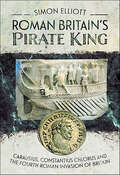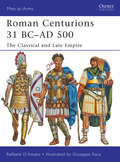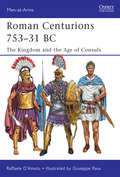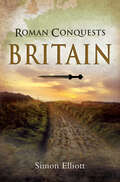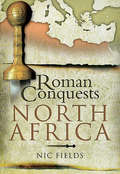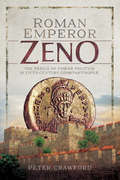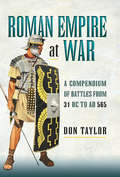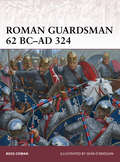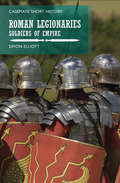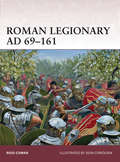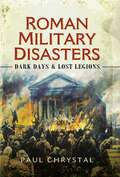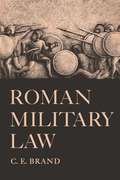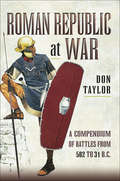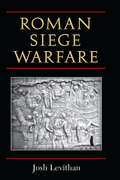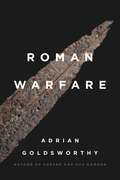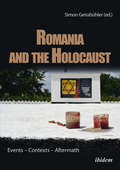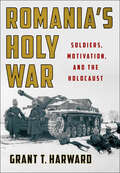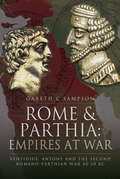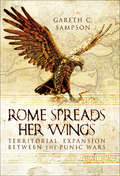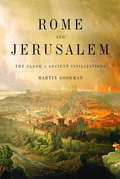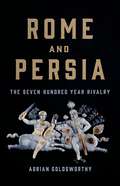- Table View
- List View
Roman Britain's Pirate King: Carausius, Constantius Chlorus and the Fourth Roman Invasion of Britain
by Simon ElliottIn the mid-3rd century AD Roman Britain’s regional fleet, the Classis Britannica, disappeared. It was never to return. Soon the North Sea and English Channel were over-run by Germanic pirates preying upon the east and south coast of Britain, and the continental coast up to the Rhine Delta. The western augustus (senior emperor) Maximian turned to a seasoned naval leader called Marcus Aurelius Mausaeus Valerius Carausius to restore order. He was so successful that Maximian accused him of pocketing the plunder he’d recaptured, ordering his execution. The canny Carausius moved first and in 286 usurped imperial authority, creating a North Sea empire in northern Gaul and Britain which lasted until 296. Dubbed the pirate king, he initially thrived, seeing off early attempts by Maximian to defeat him. However, in the early 290s Maximian appointed his new caesar (junior emperor), Constantius Chlorus (the father of Constantine the Great), to defeat Carausius. A seasoned commander, Constantius Chlorus soon brought northern Gaul back into the imperial fold, leaving Carausius controlling only Britain. Carausius was then assassinated and replaced by Allectus, his treasurer. Allectus was in turn defeated by Constantius Chlorus in AD 296 in the fourth Roman invasion of Britain, the caesar arriving just in time to prevent London being sacked by Allectus’ Frankish mercenaries. Once more Britain was part of the Roman Empire.
Roman Catholic Modernists Confront the Great War
by C. J. T. Talar Lawrence F. BarmannAt the start of the 20th century, there emerged a confrontation between optimistic faith in ongoing progress that was characteristic of Roman Catholic Modernism (1890 - 1914) and a bleaker mentality produced by the horror and death wrought the Great War. All of this together led to material devastation and a loss of cultural patrimony that was acutely felt by many of those who had invested efforts in ecclesiastical and social reform. Questions thus naturally arise: how did those who were confronted by the death and suffering of the war, in some cases very directly, reconcile their experiences with their modernist faith? How did they deal with the massive counterfactual of the Great War to religious beliefs that had looked to a future filed with promise? They had aspired to embrace modernity; how did they react when that embrace turned so deadly? These are the questions this book seeks to address.
Roman Centurions 31 BC-AD 500
by Giuseppe Rava Raffaele D'AmatoIn the years between 31 BC and AD 500 the Romans carved out a mighty empire stretching from Britain to the deserts of North Africa. The men who spearheaded this expansion were the centurions, the tough, professional warriors who led from the front, exerted savage discipline and provided a role model for the legionaries under their command.This book, the second volume of a two-part study, reveals the appearance, weaponry, role and impact of these legendary soldiers during the five centuries that saw the Roman Empire reach its greatest geographical extent under Trajan and Hadrian, only to experience a long decline in the West in the face of sustained pressure from its 'barbarian' neighbours. Featuring spectacular full-colour artwork, written by an authority on the army of the Caesars and informed by a wide range of sculptural, written and pictorial evidence from right across the Roman world, this book overturns established wisdom and sheds new light on Rome's most famous soldiers during the best-known era in its history.
Roman Centurions 753-31 BC
by Raffaele D'AmatoA detailed glimpse into the weapons, equipment and uniforms worn by Roman Centurions from the Roman Kingdom right through to the height of the Republic. Including new research, photographs of artefacts and the signature Men-at-Arms artwork, this is an essential addition to the series and includes several artwork reconstructions of actual named individuals and two lavish scenes depicting combat between Centurions and a Triumphal procession.
Roman Conquests: Britain (Roman Conquests Ser.)
by Simon ElliottThe Roman Conquests series seeks to explain when and how the Romans were able to conquer a vast empire stretching from the foothills of the Scottish Highlands to the Sahara Desert, from the Atlantic to the Persian Gulf. How did their armies adapt to and overcome the challenges of widely varied enemies and terrain? In this volume, Dr Simon Elliott draws on the latest research and archaeological evidence to present a new narrative of the conquest (never completed) of Britain. From Julius Caesar’s initial incursions in 55 and 54 BC, through the Claudian invasion of 43 AD and the campaigns of expansion and pacification thereafter, he analyses the Roman army in action. The weapons, equipment, organization, leadership, strategy and tactics of the legions and their British foes are described and analysed. The ferocity of the resistance was such that the island was never wholly subdued and required a disproportionate military presence for the duration of its time as a Roman province.
Roman Conquests: North Africa
by Nic FieldsThe third in the Roman Conquests series will briefly cover Rome's first forays into the dark continent during the First and Second Punic Wars, then cover in detail her vindictive final conquest and destruction of Carthage in the Third Punic War. The subsequent long wars against the slippery Numidian prince, Jugurtha, which tested the Roman military system to the limit, also occupy a central place. With a cast of characters including Hannibal, the Scipios, Marius, Sulla and the wily Jugurtha, this is sure to be a popular addition to the series. Like the other volumes, this book gives a clear narrative of the course of these wars, explaining how the Roman war machine coped with formidable new foes and the challenges of unfamiliar terrain and climate. Specially-commissioned color plates by Graham Sumner bring the main troop types vividly to life in meticulously researched detail.
Roman Emperor Zeno: The Perils of Power Politics in Fifth-Century Constantinople
by Peter Crawford&“A very useful read for anyone interested in the Later Roman Empire, the fall of the Western Empire, and the emergence of the Byzantine State.&” —The NYMAS Review Peter Crawford examines the life and career of the fifth-century Roman emperor Zeno and the various problems he faced before and during his seventeen-year rule. Despite its length, his reign has hitherto been somewhat overlooked as being just a part of that gap between the Theodosian and Justinianic dynasties of the Eastern Roman Empire which is comparatively poorly furnished with historical sources. Reputedly brought in as a counterbalance to the generals who had dominated Constantinopolitan politics at the end of the Theodosian dynasty, the Isaurian Zeno quickly had to prove himself adept at dealing with the harsh realities of imperial power. Zeno&’s life and reign is littered with conflict and politicking with various groups—the enmity of both sides of his family; dealing with the fallout of the collapse of the Empire of Attila in Europe, especially the increasingly independent tribal groups established on the frontiers of, and even within, imperial territory; the end of the Western Empire; and the continuing religious strife within the Roman world. As a result, his reign was an eventful and significant one that deserves this long-overdue spotlight. &“Crawford&’s work on the life and reign of Zeno is a good introduction for a general audience to the complexities of the late fifth-century Roman Empire, telling a series of long and complex stories compellingly in a traditional fashion.&” —Bryn Mawr Classical Review
Roman Empire at War: A Compendium of Battles from 31 B.C. to A.D. 565
by Don TaylorThis &“valuable&” summary of every significant battle from Augustus to Justinian I is &“an indispensable reference guide for any student of the Roman military&” (The NYMAS Review). In a single volume, Roman Empire at War catalogues and offers a brief description of every significant battle fought by the Roman Empire from Augustus to Justinian I (and most of the minor ones too). In lists arranged both alphabetically and chronologically, the information in each entry is drawn exclusively from Ancient, Late Antique, and Early Medieval texts, in order to offer a brief description of each battle based solely on the information provided by the earliest surviving sources that chronicle the event. This approach provides a concise foundation of information to which you can then confidently apply later scholarly interpretation presented in secondary sources in order to achieve a more accurate understanding of the most likely battlefield scenario. In writing the battle descriptions, the author has not sought to extensively analyze the evidence contained in the surviving accounts, nor embellish them beyond what was necessary to provide clarity to the modern reader. He allows the original writers to speak for themselves, presenting a succinct version of what the ancient chroniclers tell us of these dramatic events. It is an excellent first-stop reference to the many battles of the Roman Empire.
Roman Guardsman 62 BC-AD 324
by Ross CowanFor four centuries, from the civil wars of the Late Republic to Constantine's bloody reunification of the Empire, elite corps of guardsmen were at the heart of every Roman army. Whether as bodyguards or as shock troops in battle, the fighting skills of praetorians, speculatores, singulares and protectores determined the course of Roman history. This title details the changing nature of these units, their organization and operational successes, and failures from their origins in the late Republic through to their unsuccessful struggle against Constantine the Great.
Roman Legionaries: Soldiers of Empire (Casemate Short History)
by Simon ElliottA concise and entertaining history of the Roman legionary—from the age of Augustus through the heyday of the Roman Empire.The might of Rome rested on the back of its legions; the superbly trained and equipped fighting force with which the imperial Roman army conquered, subdued and ruled an empire for centuries. The legionary soldier served for 20 years, was rigorously trained, highly equipped, and motivated by pay, bonuses and a strong sense of identity and camaraderie. Legionaries wore full body-armor and carried a shield, as well as two javelins, a sword, and a dagger. In battle they hurled their javelins and then immediately drew their swords and charged to close combat with the enemy. They were the finest heavy infantrymen of antiquity, and a massed legionary charge was a fearsome sight.In The Roman Legionaries, Simon Elliott, author of Julius Caesar: Rome’s Greatest Warlord, provides an introduction to these elite soldiers, including their training, tactics, weapons, the men themselves, life on and off the battlefield, as well as significant triumphs and disasters in the great battles of the era.
Roman Legionary AD 69-161
by Sean O'Brogain Ross CowanBetween AD 69 and 161 the composition of the Roman legions was transformed. Italians were almost entirely replaced by provincial recruits, men for whom Latin was at best a second language, and yet the 'Roman-ness' of these Germans, Pannonians, Spaniards, Africans and Syrians, fostered in isolated fortresses on the frontiers, was incredibly strong. Like the Italian yeomen who had battled Pyrrhus and Hannibal centuries before, the provincial legionaries were imbued with the traditional ethos of the Roman army. They were highly competitive, jealous of their honour, and driven by the need to maintain and enhance their reputations for virtus, that is manly courage and excellence. The warfare of the period, from the huge legion versus legion confrontations in the Civil War of AD 69, through the campaigns of conquest in Germany, Dacia and Britain, to the defence of the frontiers of Africa and Cappadocia and the savage quelling of internal revolts, gave ample opportunity for virtus-enhancing activity. Despite a radical change in the makeup of the legions, the period AD 69-161 was characterised by continuity and revival. The classic battle formation that had baffled Pyrrhus and conquered Hannibal was revived. Heroic centurions continued to lead from the front, and common legionaries vied with them in displays of valour. The legions of the era may have been provincial but they were definitely Roman in organisation and ethos.
Roman Military Disasters: Dark Days & Lost Legions
by Paul ChrystalOver some 1200 years, the Romans proved adept at learning from military disaster and this was key to their eventual success and hegemony. Roman Military Disasters covers the most pivotal and decisive defeats, from the Celtic invasion of 390 BC to Alaric's sack of Rome in AD 410. Paul Chrystal details the politics and strategies leading to each conflict, how and why the Romans were defeated, the tactics employed, the generals and the casualties. However, the unique and crucial element of the book is its focus on the aftermath and consequences of defeat and how the lessons learnt enabled the Romans, usually, to bounce back and win.
Roman Military Law
by C. E. BrandRome was the law-giver for much of the modern world. She was also the greatest military power of antiquity, operating her military organization with remarkable efficiency and effectiveness throughout most of the then-known world. In view of the importance of both the legal and military aspects of the Roman Empire, an account of their combination in a system of disciplinary control for the Roman armies is of considerable significance to historians in both fields-and, in fact, to scholars in general. In Roman Military Law,C. E. Brand describes this system of control. Since a characterization of such a system can be made most meaningful only against a background of Roman constitutional government and in the light of ideologies current at the time, Brand follows his initial "Note on Sources" with a sketch of the contemporary Roman scene. This first section includes a discussion of the Roman constitution and an examination ofRoman criminal law. The history of Rome, as a republic, principate, and empire, extended over a period of a thousand years, so any attempt to represent a generalized picture must be essentially a matter of extraction and condensation from the voluminous literature of the whole era. Nevertheless, from the fantastic evolution that is the history of Rome, Brand has been able to construct a more or less static historical mosaic that may be considered typically"Roman. " This comes into sharpest focus during the period of the PunicWars, when the city and its people were most intensely Roman. The picture of the Roman armies is set into this basic framework, in chapters dealing with military organization, disciplinary organization, religion and discipline, and offenses and punishments. The final section of the book considers briefly the vast changes in Romaninstitutions that came about under the armies of the Empire, and then concludes with the Latin text and an English translation of the only knowncode of Roman military justice, promulgated sometime during the laterEmpire, preserved in Byzantine literature, and handed down to medieval times in Latin translations of Byzantine Greek law, which it has heretofore been confused.
Roman Republic at War: A Compendium of Battles from 502 to 31 B.C.
by Don TaylorDescriptions of every significant battle fought by the Roman Republic between 480 and 31 BC—and most of the minor ones too: &“Amazing&” (Books Monthly). The information in each entry of this remarkable book is drawn exclusively from ancient texts in order to offer a brief description of each battle based solely on the information provided by the earliest surviving sources that chronicle the event. This approach provides the reader a concise foundation of information to which they can then confidently apply later scholarly interpretation presented in secondary sources, achieving a more accurate understanding of the most likely battlefield scenario. In writing the battle descriptions, the author has not sought to analyze the evidence contained in the surviving accounts, nor embellish them beyond that which was necessary to provide clarity to the modern reader. He allows the original writers to speak for themselves, presenting the reader with a succinct version of what the ancient chroniclers tell us of these dramatic events. It is an excellent first-stop reference to the many battles of the Roman Republic. &“An indispensable reference guide for any student of the Roman military.&” —The NYMAS Review
Roman Siege Warfare
by Josh LevithanRoman siege warfare had its own structure and customs, and expectations both by the besieged and by the attacking army. Sieges are typically sorted by the techniques and technologies that attackers used, but the more fruitful approach offered in Roman Siege Warfare examines the way a siege follows or diverges from typical narrative and operational plotlines. Author Josh Levithan emphasizes the human elements--morale and motivation--rather than the engineering, and he recaptures the sense of a siege as an event in progress that offers numerous attitudes, methods, and outcomes. Sieges involved a concentration of violent effort in space and the practical challenge posed by a high wall: unlike field battles they were sharply defined in time, in space, and in operational terms. Chapters examine motivation and behavior during a siege and focus on examples from both the Roman Republic and the Empire: Polybius, Livy, Julius Caesar, Flavius Josephus, and Ammianus Marcellinus. Levithan examines the "gadgetary turn," during which writers began to lavish attention on artillery and wall-damaging techniques, fetishizing technology and obscuring the centrality of the assault and of human behavior. This volume speaks to classicists and historians of all stripes. All passages are translated, and references are accessible to nonspecialists. Military historians will also find much of interest in the volume, in its treatment both of Roman military conduct and of wider military practice.
Roman Soldier vs Germanic Warrior
by Peter Dennis Lindsay PowellFrom the annals of Tacitus we get a one-sided vision of the Romano-Germanic wars. More recent scholarship, including Osprey's Teutoburg Forest Campaign book, paints a more balanced picture. Yet, there's still a lot of ground to cover on the subject. The reigns of Augustus and his successor Tiberius saw an epic struggle between the Romans and local peoples for the territory between the Rhine and Elbe rivers in what is now Germany. Following two decades of Roman occupation, Germania Magna erupted into revolt in AD 9 following the loss of the three legions commanded by Publius Quinctilius Varus to the Cheruscan nobleman Arminius and an alliance of Germanic nations in the dense forests of the Teutoburger Wald. The Romans' initial panic subsided as it became clear that Arminius and his allies could not continue the war into Germania Inferior on the western bank of the Rhine, and Imperial troops poured into the region as the Romans decided how best to resolve the situation.In AD 14 Tiberius' adopted son, Germanicus Caesar, quelled a mutiny among Roman forces in the area, then took his men on a quick punitive raid into Germanic territory. In the following year he snatched the wife and father-in-law of Arminius and located the site of the 'Varian Disaster', where he oversaw burial of the bones of Roman dead and erected a cenotaph. In AD 16 Germanicus set out to engage his Cheruscan adversary and defeat him decisively with a view to tipping the balance of power in the region as a prelude to restoring full Roman control over territory between the Rhine and the Elbe. By that summer, the Germanicus had tracked down Arminius to a location on the Weser River in the region of modern-day Minden. An initial engagement - called the battle of Weser River - ended in a draw when a Roman cavalry charge was repulsed by Arminius' own cavalry and Germanicus withdrew his men. Having transferred his force across the river and camped for the night, he laid out a plan for a set-piece battle with his opponent at a place called the Plain of Idistaviso.Idistaviso was the first battle the Romans won against Arminius since Teutoburg. It proved they could beat him. Despite his unique understanding of both Roman and Germanic strategy and tactics, Arminius' failure to anticipate the Roman defence in depth, compounded by dissimilarities in arms and equipment, and confusion on the ground, made this battle particularly vicious and bloody. Better led and disciplined, and with a robust battle strategy, Germanicus' men decisively defeated Arminius'. At the ensuing battle of the Angrivarian Wall the Romans crushed the Germans again.Featuring full-color artwork, specially drawn maps and an array of revealing illustrations depicting weapons, equipment, key locations and personalities, this study offers key insights into the tactics, leadership, combat performance, and subsequent reputations of the Roman soldiers and their Germanic opponents pitched into a series of pivotal actions on the Imperial frontier that would influence Roman/German relations for decades to come.
Roman Warfare (Smithsonian History Of Warfare Ser.)
by Adrian GoldsworthyFrom an award-winning historian of ancient Rome, a concise and comprehensive history of the fighting forces that created the Roman EmpireRoman warfare was relentless in its pursuit of victory. A ruthless approach to combat played a major part in Rome's history, creating an empire that eventually included much of Europe, the Near East and North Africa. What distinguished the Roman army from its opponents was the uncompromising and total destruction of its enemies. Yet this ferocity was combined with a genius for absorbing conquered peoples, creating one of the most enduring empires ever known.In Roman Warfare, celebrated historian Adrian Goldsworthy traces the history of Roman warfare from 753 BC, the traditional date of the founding of Rome by Romulus, to the eventual decline and fall of Roman Empire and attempts to recover Rome and Italy from the "barbarians" in the sixth century AD. It is the indispensable history of the most professional fighting force in ancient history, an army that created an Empire and changed the world.
Romania and the Holocaust: Events – Contexts – Aftermath
by Simon GeissbühlerFrom summer 1941 onwards, Romania actively pursued at its own initiative the mass killing of Jews in the territories it controlled. 1941 saw 13,000 Jewish residents of the Romanian city of Ia?i killed, the extermination of thousands of Jews in Northern Bukovina and Bessarabia by Romanian armed forces and local people, large-scale deportations of Jews to the camps and ghettos of Transnistria, and massacres in and around Odessa. Overall, more than 300,000 Jews of Romanian and Soviet or Ukrainian origin were murdered in Romanian-controlled territories during the Second World War. In this volume, a number of renowned experts shed light on the events, context, and aftermath of this under-researched and lesser-known dimension of the Holocaust. 75 years on, this book gives a much-needed impetus to research on the Holocaust in Romania and Romanian-controlled territories.
Romania's Holy War: Soldiers, Motivation, and the Holocaust (Battlegrounds: Cornell Studies in Military History)
by Grant T. HarwardRomania's Holy War rights the widespread myth that Romania was a reluctant member of the Axis during World War II. In correcting this fallacy, Grant T. Harward shows that, of an estimated 300,000 Jews who perished in Romania and Romanian-occupied Ukraine, more than 64,000 were, in fact, killed by Romanian soldiers. Moreover, the Romanian Army conducted a brutal campaign in German-occupied Ukraine, resulting in the deaths of thousands of Soviet prisoners of war, partisans, and civilians. Investigating why Romanian soldiers fought and committed such atrocities, Harward argues that strong ideology—a cocktail of nationalism, religion, antisemitism, and anticommunism—undergirded their motivation. Romania's Holy War draws on official military records, wartime periodicals, soldiers' diaries and memoirs, subsequent war crimes investigations, and recent interviews with veterans to tell the full story. Harward integrates the Holocaust into the narrative of military operations to show that most soldiers fully supported the wartime dictator, General Ion Antonescu, and his regime's holy war against "Judeo-Bolshevism." The army perpetrated mass reprisals, targeting Jews in liberated Romanian territory; supported the deportation and concentration of Jews in camps or ghettos in Romanian-occupied Soviet territory; and played a key supporting role in SS efforts to exterminate Jews in German-occupied Soviet territory. Harward proves that Romania became Nazi Germany's most important ally in the war against the USSR because its soldiers were highly motivated, thus overturning much of what we thought we knew about this theater of war. Romania's Holy War provides the first complete history of why Romanian soldiers fought on the Eastern Front.
Rome & Parthia: Ventidius, Antony and the Second Romano-Parthian War, 40–20 BC
by Gareth C. SampsonA Roman historian examines the motivation and strategy behind Marc Anthony’s invasion of Parthia and the reasons for its ultimate defeat.In the mid-first century BC, the Roman Empire was rivaled only by the Parthian Empire to the east. The first war between these two ancient superpowers resulted in the total defeat of Rome and the death of Marcus Crassus. When Rome collapsed into Civil War in the 1st century, BC, the Parthians took the opportunity conquer the Middle East and drive Rome back into Europe. What followed was two decades of war which saw victories and defeats on both sides. The Romans were finally able to gain a victory over the Parthians thanks to the great general Publius Ventidius. These victories acted as a springboard for Marc Antony’s plans to conquer the Parthian Empire, which ended in ignominious defeat. In this authoritative history, Gareth Sampson analyses the military campaigns and the various battles between Rome and Parthia. He provides fascinating insight into the war that in many ways defined the Middle East for the next 650 years.
Rome In The Teutoburg Forest
by LCDR James L. VenckusThis paper examines the battle of Teutoburg (9 A.D.), its consequences on the Roman world, and the role cultural misunderstanding played on the tactical, operational, and strategic levels. The Roman commander's cultural misunderstanding of his enemy caused mistakes at the operational and tactical levels, while the Roman Emperor's cultural misunderstanding brought about mistakes at the strategic level and created poor policy decisions following the battle, which affected Rome like no other battle in its history. Chapter 2 examines the consequences of other Roman loses (with much higher casualties) to show how none of them carried the same impact as the Teutoburg loss. They were but temporary "setbacks", while Teutoburg was Rome's first military "defeat" in its history. The Roman direction of conquest into Germania and the image of the pre-Teutoburg Germanic barbarian (an image which changes greatly into an elevated status following the massacre) are also examined. Chapter 3 examines the commanders of both sides and the battle itself. Chapter 4 looks at the significance of this loss. This battle caused Rome to adopt its first permanent defensive boundary and set the first limit of the Roman Empire.
Rome Seizes the Trident: The Defeat of Carthaginian Seapower & the Forging of the Roman Empire
by Marc G. DeSantisSeapower played a greater part in ancient empire building than is often appreciated. The Punic Wars, especially the first, were characterized by massive naval battles. The Romans did not even possess a navy of their own when war broke out between them and the Carthaginians in Sicily in 264 B.C. Prior to that, the Romans had relied upon several South Italian Greek cities to provide ships in the same way as its other allies provided soldiers to serve with the legions. The Romans were nevertheless determined to acquire a navy that could challenge that of Carthage. They used a captured galley as a model, reverse engineered it, and constructed hundreds of copies. The Romans used this new navy to wrench maritime superiority from the Carthaginians, most notably at the Battle of Ecnomus where they prevailed through the use of novel tactics. Although not decisive on its own, Rome's new found naval power was, as Marc De Santis shows, a vital component in their ultimate victory in each of the three Punic Wars.
Rome Spreads Her Wings: Territorial Expansion Between the Punic Wars
by Gareth C. SampsonThe two decades between the end of the First Punic War and the beginning of the Second represent a key period in the development of Romes imperial ambitions, both within Italy and beyond. Within Italy, Rome faced an invasion of Gauls from Northern Italy, which threatened the very existence of the Roman state. This war culminated at the Battle of Telamon and the final Roman victory against the Gauls of Italy, giving Rome control of the peninsula up to the Alps for the first time in her history. Beyond the shores of Italy, Rome acquired her first provinces, in the form of Sardinia and Corsica, established footholds in Sicily and Spain and crossed the Adriatic to establish a presence on the Greek mainland, bringing Rome into the orbit of the Hellenistic World. Yet this period is often treated as nothing more than an intermission between the two better known Punic Wars, with each Roman campaign being made seemingly in anticipation of a further conflict with Carthage. Such a view overlooks two key factors that emerge from these decades: firstly, that Rome faced a far graver threat in the form of the Gauls of Northern Italy than she had faced at the hands of the Carthaginians in the First Punic War; secondly, that the foundations for Romes overseas empire were laid in these very decades. This work seeks to redress the balance and view these wars in their own right, analyse how close Rome came to being defeated in Italy and asses the importance of these decades as a key period in the foundation of Romes future empire.
Rome and Jerusalem: The Clash of Ancient Civilizations
by Martin GoodmanA magisterial history of the titanic struggle between the Roman and Jewish worlds that led to the destruction of Jerusalem.Martin Goodman—equally renowned in Jewish and in Roman studies—examines this conflict, its causes, and its consequences with unprecedented authority and thoroughness. He delineates the incompatibility between the cultural, political, and religious beliefs and practices of the two peoples and explains how Rome's interests were served by a policy of brutality against the Jews. At the same time, Christians began to distance themselves from their origins, becoming increasingly hostile toward Jews as Christian influence spread within the empire. This is the authoritative work of how these two great civilizations collided and how the reverberations are felt to this day.From the Trade Paperback edition.
Rome and Persia: The Seven Hundred Year Rivalry
by Adrian GoldsworthyA &“magnificent&” (Spectator) history of the epic rivalry between the ancient world&’s two great superpowers The Roman empire was like no other. Stretching from the north of Britain to the Sahara, and from the Atlantic coast to the Euphrates, it imposed peace and prosperity on an unprecedented scale. Its only true rival lay in the east, where the Parthian and then Persian empires ruled over great cities and the trade routes to mysterious lands beyond. This was the region Alexander the Great had swept through, creating a dream of glory and conquest that tantalized Greeks and Romans alike. Tracing seven centuries of conflict between Rome and Persia, historian Adrian Goldsworthy shows how these two great powers evolved together. Despite their endless clashes, trade between the empires enriched them both, and a mutual respect prevented both Rome and Persia from permanently destroying the other. Epic in scope, Rome and Persia completely reshapes our understanding of one of the greatest rivalries of world history.
